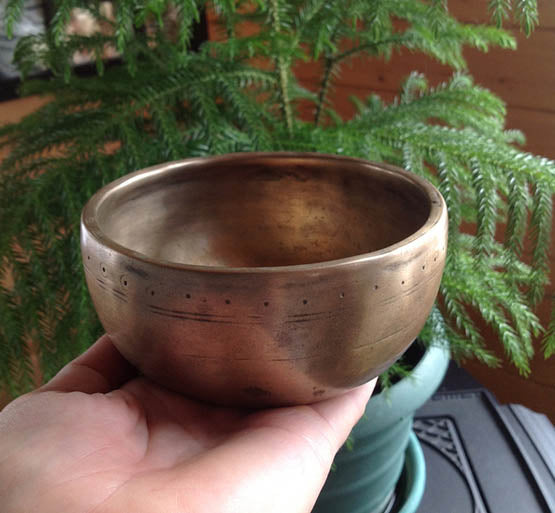
History of Singing Bowls
The mystery of the antique Himalayan singing bowl!
Since many of us singing bowl coinsurers will likely never get the opportunity to visit Nepal or Tibet, some of us would have to rely on the Internet in hopes to find out the answers to our questions about these wonderful bowls. As you know, you can't believe everything that is written out there. Fortunately, there are some dedicated people who were quite serious about sorting fact from fiction and simply traveled to Nepal and Tibet to find out themselves. There they lived among the people, sometime for years at a time, to search the origins of the Himalayan singing bowl.
Here is only a smidgen of what they came back with:

- Although commonly called "Tibetan singing bowls", they are likely not Tibetan at all. These bowls were made out of the raw materials that were available in the region they came from (Nepal, Bhutan, India).
- Bowls uses were likely utilitarian in nature, in other words, used as food dishes or chalices. It is possible that they were used in various monasteries in ceremony, however, for those who have traveled to Nepal and Tibet to verify, it was hard to find proof.
- Legend tells us that the early singing bowls were made out of seven or twelve sacred metals. Meteorites have also been reported to have been used! In the end, Blacksmiths likely used what was available to them in the area they lived or worked in. Bowls were made out of mostly copper and tin. The copper found in the Himalayans is found nowhere else in the world!
- Inscription marks on these antique bowls are generally family names, not mantra's, as some would lead you to believe.
Current usages of singing bowls actually mirrors best the fabled historical uses of singing bowls. It is not uncommon to find antique and new bowls being use for sound healing (harmonic therapy) music therapy, religious/ceremonial services, and meditation aids for individuals or groups.
My Adventures
in Katmandu
-

Katmandu, Nepal 2014
-

The true start of a new singing bowl
-

Metals have been melted and are now being poured
-

Here is what goes into the fire when ready to make a singing bowl
-

The start of a new singing bowl being made in Katmandu
-

Up close, two bowls at once being hammered
-

Yes, even the new bowls are hand hammered
-

Bowl has been shaped, but more hammering to do
-

Getting the shine on in Katmandu
-

The product of a lot of hard work - new singing bowls of all sizes
-

Opportunity to pick out antiques in person, what a blessing this was
-

Our teachers, Mitch Nur, Ph.D and his wonderful wife Michelle guided us on a most memorable trip to Katmandu - 2014!
For Fun and Education
-

Aspen mallets are the bomb. Yes, product of Colorado
-

Bowls are placed above, to the side and underneath for optimum vibration!
-

Linda playing her new baby, the Contra B
-

Contra B Burmese Nipple gong - 34 inches
-

Linda learning the fine techniques of playing the gong
-

Intergalactic Master Control (says my teacher)
-

Can you see the Copper in some of these bowls? Not considered a defect!
-

Sorry folks, this one not for sale
-

My grand-daughter with a jewel of a bowl
-

Comos - a 38" Italian gong from Grotta Sonora
-

Titanium bell beauties from Ross Barrable
-

A very fine cup bowl
-

Fun and relaxation can be found in the studio!
-
The Edge of Silence
-
☎️ 970-389-9422
- Open on all Saturdays: 10:00 am to 3:00 pm
- Monday thru Fridays: by appointment only (just give us a call)
- Public Sound Journeys – 1st, 3rd and 5th Saturdays of each month @ 1:00 pm
- Private Individual, Couple and Group Sound Journeys are scheduled by appointment (just give us a call)

























